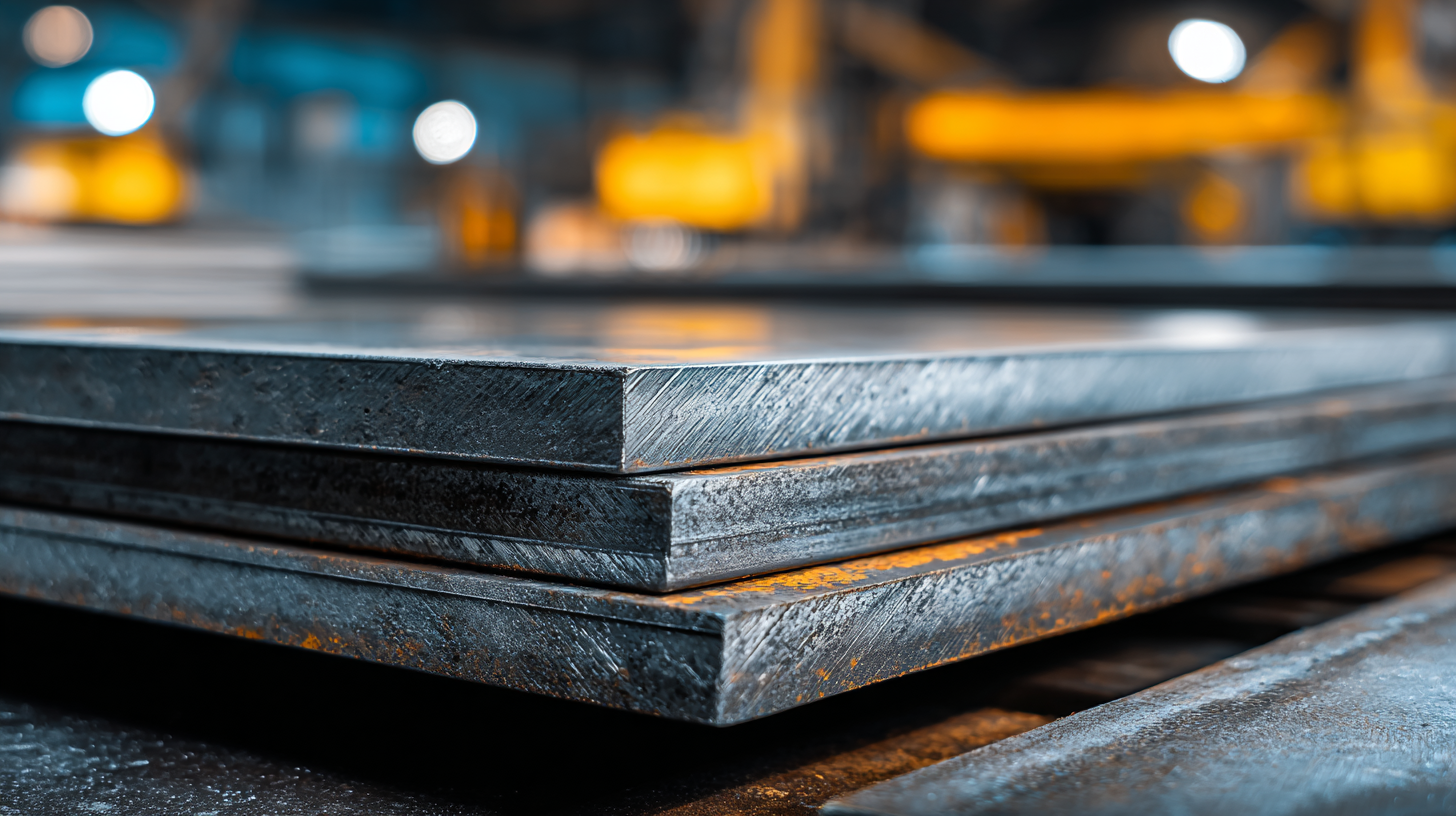
In the rapidly evolving landscape of the Plate Sheet industry, staying ahead of digital trends is vital for success. With advancements in technology and shifts in market demands, companies must adapt to thrive. According to Dr. Emily Carter, a leading expert in materials technology, "Embracing digital transformation is no longer an option; it is a necessity for the Plate Sheet industry to enhance efficiency and compete in a global market."
As we look towards 2025, the integration of innovative digital solutions is expected to redefine production processes, improve supply chain management, and elevate customer engagement strategies. This article explores the top five digital trends poised to impact the Plate Sheet industry, providing valuable market insights and growth projections essential for industry stakeholders. By understanding these trends, businesses can strategically position themselves to harness opportunities and navigate challenges in the coming years.
With an emphasis on sustainability and the increasing importance of data analytics, the Plate Sheet sector is set for a transformative journey. The trends discussed herein will not only shape the future of production but will also play a crucial role in meeting the evolving demands of consumers and the global market as a whole.

The plate sheet industry is poised for a significant transformation by 2025, driven by the rapid adoption of emerging technologies. Advanced manufacturing techniques, such as additive manufacturing and automated processes, are set to enhance production efficiency and precision. These innovations will not only reduce material wastage but also enable the creation of complex geometries that were previously unattainable. The integration of Industry 4.0 principles, including IoT and data analytics, will further optimize operations, allowing for real-time monitoring and predictive maintenance, which can significantly reduce downtime and operational costs.
Moreover, sustainability is becoming a central theme in the plate sheet industry, with emerging technologies focused on eco-friendly materials and processes. The utilization of recycled metals and the development of biodegradable coatings illustrate a shift towards reducing the environmental footprint. Innovations in energy-efficient production methods are also expected to gain traction, aligning with global sustainability goals. As these technologies unfold, they will not only reshape the market landscape but also contribute to the industry's resilience and adaptability in an ever-evolving economic environment.
| Trend | Description | Projected Growth (%) | Impact on Industry |
|---|---|---|---|
| Digital Twin Technology | Virtual representation of physical assets to optimize performance and predictive maintenance. | 15% | Increased operational efficiency and reduced downtime. |
| IoT Integration | Connecting machinery and systems to provide real-time data and analytics. | 20% | Enhanced monitoring and decision-making capabilities. |
| Advanced Robotics | Automation of production processes using robotic technologies. | 25% | Improved efficiency and lower labor costs. |
| Sustainable Practices | Adoption of eco-friendly materials and processes. | 30% | Reduced environmental impact and enhanced brand reputation. |
| Data Analytics | Utilizing big data to drive insights and make informed decisions. | 18% | Improvement in market adaptability and risk management. |
The integration of automation and AI in the plate sheet industry is revolutionizing production efficiency and cost management. According to a recent industry report by MarketsandMarkets, the global market for industrial automation is projected to reach $265 billion by 2025, with manufacturing sectors like the plate sheet industry leading the adoption. Automation technologies enable manufacturers to optimize workflows, reduce labor costs, and minimize errors, ultimately leading to substantial improvements in throughput and product quality.
AI plays a critical role in predictive maintenance and real-time analytics, allowing producers to anticipate equipment failures before they occur, significantly decreasing downtime. A McKinsey report estimates that AI could contribute up to $2.6 trillion in value annually for the manufacturing sector, primarily by enhancing operational efficiency and reducing inefficiencies. By leveraging these advancements, plate sheet companies can see margins increase while sustaining competitiveness in a challenging market.
Tips: To maximize the benefits of automation and AI, companies should invest in training for their workforce to ensure they can effectively operate and collaborate with new technologies. Additionally, incorporating smart sensors and IoT devices can further improve data collection and analysis, leading to more informed decision-making and increased operational agility. Finally, continuous evaluation and adaptation of these technologies will be crucial for staying ahead in the rapidly evolving industrial landscape.
Sustainable manufacturing practices are increasingly becoming a cornerstone of the plate sheet industry, significantly driving growth and innovation. As companies face mounting pressure to reduce their environmental footprint, many are adopting eco-friendly materials and processes. Such practices include utilizing recycled raw materials, optimizing energy consumption during production, and implementing waste reduction strategies. This shift not only meets regulatory demands but also aligns with the growing consumer preference for sustainable products.
The adoption of these practices is expected to yield substantial market benefits. Companies that proactively embrace sustainability often enjoy enhanced brand loyalty and a competitive edge. By integrating renewable energy sources and investing in clean technologies, businesses can lower operational costs and improve efficiency. Furthermore, as sustainability becomes a key differentiator in the marketplace, firms that prioritize these initiatives are well-positioned to capitalize on emerging market opportunities and drive long-term growth in the plate sheet industry.

The competitive landscape of the plate sheet industry is expected to evolve significantly by 2025, influenced by various digital trends and market dynamics. Key players in the sector are leveraging advanced technologies to enhance operational efficiency and product offerings. For instance, research indicates a projected market growth driven by an increasing demand for high-quality materials and innovative manufacturing processes. With the global market size for certain materials witnessing a CAGR of over 4.84%, it’s imperative for companies to adopt strategic initiatives to capture a larger market share.
In addition to technological advancements, the need for sustainability and energy efficiency is reshaping the competitive environment. Companies are focusing on the development of eco-friendly products and implementing smart manufacturing practices. Furthermore, insights from multiple industry reports indicate that leading firms will likely prioritize research and development, alongside competitive pricing strategies, to maintain their edge in an increasingly crowded market. Understanding consumer behavior trends and adapting to these insights will be crucial for businesses aiming to thrive and expand in the evolving plate sheet industry landscape by 2025.
The digital transformation within the plate sheet industry is significantly influenced by emerging technologies, pushing companies to adapt to new market realities. Digital solutions, particularly in the realms of software and services, are reshaping operational efficiencies and customer engagement strategies. As organizations leverage data analytics and cloud technologies, they are witnessing an acceleration in decision-making processes, leading to enhanced production capabilities and improved product quality.

Growth projections for digital solutions indicate a robust expansion in the coming years, driven by increasing demands for automation and real-time data integration. This trend is particularly evident in applications such as aircraft systems and airport information management, where technology not only streamlines operations but also enhances safety and customer experience. The ongoing evolution of these technologies will continue to play a critical role in shaping industry dynamics, offering companies a competitive edge as they navigate the complexities of a post-pandemic market.





